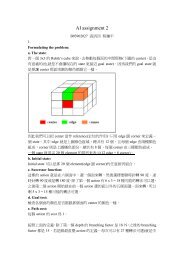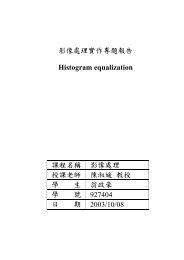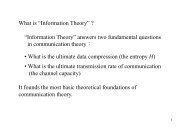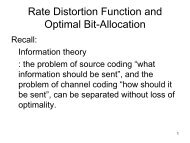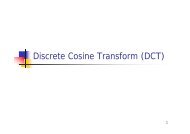Exaggeration of Facial Features in Caricaturing
Exaggeration of Facial Features in Caricaturing
Exaggeration of Facial Features in Caricaturing
You also want an ePaper? Increase the reach of your titles
YUMPU automatically turns print PDFs into web optimized ePapers that Google loves.
First Part<br />
Figure 6. The Tone-Shad<strong>in</strong>g Method.<br />
picture, but rather color it accord<strong>in</strong>g to our own rules. We<br />
divide the range <strong>of</strong> color <strong>in</strong>to four parts. The first part is the<br />
base face color that is about n<strong>in</strong>ety percent white, five<br />
percent yellow, and five percent orange. The second and<br />
third parts are heavier <strong>in</strong> orange and yellow, which are <strong>of</strong>ten<br />
used to display shadow. The fourth color has more white,<br />
which is <strong>of</strong>ten used to display reflected light. Shadows that<br />
we draw <strong>of</strong>ten occur <strong>in</strong> six regions. The first is between the<br />
eyes and the nose. The second is underneath the nose. The<br />
third is under the cheekbone. The fourth is upon the mouth.<br />
The fifth is along the outl<strong>in</strong>e <strong>of</strong> the face. The sixth is under<br />
the lower lip. An example is shown <strong>in</strong> Figure 6.<br />
3.6 Layer Render<strong>in</strong>g<br />
After exaggerat<strong>in</strong>g the features, some features may<br />
overlap the others. In order to avoid those abnormal results,<br />
our system implements layer render<strong>in</strong>g. We separate the<br />
features <strong>in</strong>to seven layers, shown <strong>in</strong> Figure 7. In the order<br />
Face<br />
Layer<br />
Botto<br />
m<br />
Second Part<br />
Shadow<br />
Layer<br />
Mouth<br />
Layer<br />
Third Part<br />
Nose<br />
Layer<br />
Reflection Light<br />
Eye<br />
Layer<br />
Reflect<br />
Light<br />
Layer<br />
from the bottom layer to the top layer, they are “face layer”,<br />
“shadow layer”, “mouth layer”, “nose layer”, “eye layer”,<br />
“reflect light layer” and “hair layer” respectively. Then we<br />
render the layers <strong>in</strong> the same order.<br />
4 Conclusion and Future Works<br />
Future research can br<strong>in</strong>g improvements to the part <strong>of</strong><br />
facial features exaggeration. For example, the outl<strong>in</strong>e <strong>of</strong> a<br />
face can be exaggerated more sharply. We can add more<br />
characteristics that can be exaggerated. We also hope that we<br />
can draw wavier hair so that the result can be closer to the<br />
style <strong>of</strong> the orig<strong>in</strong>al artist, the manga style. Furthermore, we<br />
would also like to merge a talk<strong>in</strong>g head system <strong>in</strong>to our<br />
system, and let our system to make some <strong>in</strong>terest<strong>in</strong>g<br />
animations. The most important th<strong>in</strong>g is to make our system<br />
available for public use on Internet.<br />
5 Results<br />
As depicted <strong>in</strong> the beg<strong>in</strong>n<strong>in</strong>g <strong>of</strong> this paper, we see the<br />
comparison <strong>of</strong> an orig<strong>in</strong>al picture, a picture without<br />
exaggeration and a picture with exaggeration. The follow<strong>in</strong>g<br />
figure shows more render<strong>in</strong>g results.<br />
6 Acknowledgements<br />
This project is partially funded by the National Science<br />
Council (NSC, Taiwan) under the grant number<br />
NSC90-2622-E-002-008.<br />
7 References<br />
[1] Gooch, B., AND Gooch, A. Non-Photorealistic<br />
Render<strong>in</strong>g. 2001. AK Peters Ltd, Publishers.<br />
[2] Cassidy J. Curtis, Sean E. Anderson, Kurt W. Fleischer,<br />
and David H. Sales<strong>in</strong>. Computer-Generated Watercolor. Proc.<br />
Hair<br />
Layer<br />
Figure 7. Layer Render<strong>in</strong>g: Draw<strong>in</strong>g the layers from bottom to top.<br />
Top Result





